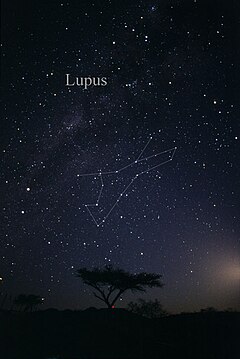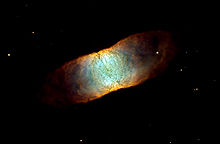Lupus (constellation)
Lupus (the wolf) is a constellation in the southern hemisphere located between the constellations of Centaurus and Scorpius. It is found between the legs of the scorpion and almost attached to the centaur. From Spain (including central Europe) you can only see the northernmost part of the constellation, at the time of transit through the meridian, at the beginning of summer.
Notable features
Lupus is a small constellation that, without having any extremely bright stars, contains around thirty second and third magnitude stars, including a number of binary or multiple stars. The brightest among them, α Lupi, is occasionally known as Kakkab or Men. It is a blue giant of spectral type B1.5III with a mass 10 times that of the Sun. It is a Beta Cephei variable whose brightness fluctuates between magnitude 2.29 and 2.34. The second brightest star, β Lupi, is also a blue giant of type B2III of 8 solar masses distant 524 light-years from the Solar System. Both stars, as well as many others in this constellation, are part of an OB stellar association called the "Superior Centaurus-Lupus" subassociation or UCL, in turn included in the great Scorpius-Centaurus Association.
The third brightest star is γ Lupi, occasionally called Thusia, a binary system made up of a bluish-white subgiant and a B-type main sequence star. The orbital period of this system is 190 years, the orbit being markedly eccentric. It is also a member of the UCL stellar association, as are ε Lupi and η Lupi, triple stellar systems whose main component also has spectral type B.
χ Lupi is a spectroscopic binary whose main component —a bluish-white subgiant of type B9IV— shows in its spectrum especially high contents of certain elements such as platinum, gold and mercury; specifically, the abundance of this last element is a million times higher than in the Sun.
Another star of interest is ν² Lupi, a solar analogue of spectral type G4V that is 47.5 light-years from Earth. Unlike the Sun, it is an ancient star with an age of more than 10 billion years. Three "super-Earth" type planets orbit around it at a distance between 0.1 and 0.4 AU. Also with a planetary system, Gliese 588 is a red dwarf of type M2.5V distant 19 light years from Earth. A circumstellar disk of debris has been detected around g Lupi—an F-type main sequence star—and imaged with the ACS instrument of the Hubble Space Telescope.
Among the constellation variables is GQ Lupi, a T Tauri star with a substellar companion that was directly imaged with the VLT telescope. Other T Tauri stars in the constellation are RU Lupi, a very young star with an age of only 2 or 3 million years surrounded by a circumstellar disk of dust and showing random brightness variations, and IM Lupi, estimated to be 100 years old. 000 and 10 million years.
II Lupi, another variable in the constellation, is a cool carbon star whose effective temperature is only 2400 K. Listed as a Mira variable, its H-band brightness fluctuation is 1.6 magnitudes and its period of pulsation of 575 days. Z Lupi is also a carbon star with a surface temperature of 3288 K.
In this constellation is also found the Retina Nebula (IC 4406), a cylindrical planetary nebula. Gas and dust emanating from the dying star create a "doughnut" structure around it, of which we only see one side. Another planetary nebula, NGC 5882, has a roughly elliptical shape with several clumps of ionized material and is surrounded by a larger region extending up to three times the diameter of the parent nebula. Its central star has a temperature of about 70 000 K. According to the parallax measured by the GAIA space observatory, NGC 5882 is 6,430 light-years from Earth.
In Lupus some star clusters can be observed. NGC 5986 is a globular cluster with two very luminous stars of spectral type A-F; distant 34,000 light-years from Earth, it moves in an irregular and highly eccentric orbit around the center of the galaxy. Also, NGC 5927 is a metal-rich globular cluster 25,100 light-years away. Near the border with Centaurus is the cluster NGC 5824, whose estimated age is 12.8 billion years.
In the year 1006, the supernova SN 1006 was observed in Lupus. Described by Chinese and Arab astronomers, its brightness reached magnitude -7.5, making it the stellar event with the largest visual magnitude recorded in history. According to Ali ibn Ridwan, an astrologer and astronomer who observed the event, the intensity of its light was just over a quarter of the light of the Moon.
Main Stars
- α Lupi (Kakkab or Men), the brightest star of constellation with apparent magnitude 2,30. At about 550 light years, it is a blue giant and a variable of the Beta Cephei type.
- β Lupi, second brightest star of constellation with apparent magnitude 2,68, is a giant star similar to the previous one.
- γ Lupi (Thusia), also blue star of magnitude 2.80. It is a binary star whose two components are separated less than a second of arc.
- δ Lupi, blue subgiant star of magnitude 3.22.
- ε Lupi, visual binary whose main component is in turn a spectroscopic binary.
- Moon Lupi, unlike other stars of the constellation that are white-blue, is a yellow giant. It is about 5 times closer than the previous five stars.
- η Lupi, binary star whose components are separated 15 seconds of arc.
- ι Lupi, a subject of magnitude 3.54.
- κ1 Lupi or κ Lupi, star Be of magnitude 3,85.
- μ Lupi, star system of magnitude 4,27.
- . Lupi designates two different stars: ν1 Lupi, yellow star somewhat hotter than the Sun located at 111 light years; ν2 Lupi, yellow dwarf very similar to the Sun at 47.5 light years. The latter has three extra-solar planets of "supertier" type.
- σ Lupi, blue star and rotating ellipsoidal variable of magnitude 4,41.
- χ Lupi, spectroscopic binary whose main component is an interesting example of mercury-manganese star.
- 2 Lupi (f Lupi), an orange giant and member of the Scorpius-Centaurus star association.
- g Lupi (HD 139664), yellow star with a circum-stellar disk around it, similar to the existing Kuiper belt on the Solar System.
- GG Lupi, eclipsing binary composed of two spectral-type B stars.
- GQ Lupi, variable T Tauri with a sub-stellar companion. The mass of the accompanying object is uncertain, being between 1 and 36 times the mass of Jupiter.
- HR Lupi, HZ Lupi and IT Lupi, variables Alfa2 Canum Venaticorum of magnitude 5,76, 5,97 and 6,62 respectively.
- II Lupi, distant carbon star about 1800 light years.
- IM Lupi and RU Lupi, T Tauri stars surrounded by a ring disk.
- HD 140901 (HR 5864), yellow-orange sub-gigante distant 50 light years.
- Gliese 588 (CD-40 9712), red dwarf at 19.36 light years of the Earth.
- SSSPM J1549-3544, a star with a great movement of its own, probably a sub-enana crossing at high speed the proximity of the Solar System.
- SN 1006, supernova that in 1006 reached magnitude -7,5. The rest of the associated supernova is the PKS radius 1459-41.
Deep Sky Objects
- To the north of the constellation two globular clusters can be observed: NGC 5824 and NGC 5986. None are visible with prismatics, even if they do with small telescopes.
- Glybular cluster NGC 5927, about 24 000 light years away, such as the previous only visible with telescope.
- Two clusters open south of the constellation, NGC 5822 and NGC 5749.
- On the west edge, the planetary nebula IC 4406 or Nebula Retina is located. Distant 2000 light years of the Earth, it is a bipolar nebula seen from our position. Its right and left side are practically identical.
- Another interesting planetary nebula, NGC 5873, is located about 13 500 light years from the Solar System.
- NGC 5882 is another planetary nebula to the center of constellation. Its central star is not in the center of symmetry but shifted towards its western side.
- Rest of supernova SNR G330.0+15.0, with an estimated age around 30 000 years.
- Rotary spiral galaxy NGC 5643.
Mythology
According to the legend, it is the king of Arcadia, Lycaon, who was transformed into a wolf as punishment for his extreme cruelty, since he came to kill almost all of his children.
Contenido relacionado
Canis major
Star catalog
Crux






